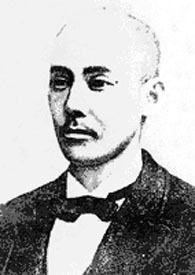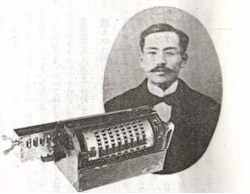|
Chūhachi Ninomiya
was a Japanese aviation pioneer. He is remembered for his unique aircraft designs - the "Karasu-gata mokei hikouki" ("Crow-type model aircraft", 1891) and the "Tamamushi-gata hikouki" (" Jewel beetle type flyer", 1893). He designed a flying machine with three engines earlier than the Wright brothers, and, even though the machine failed to take off, it contributed to Japan's accumulation of capabilities to design and manufacture aircraft by the 1930s. Early life Chūhachi was born in Yawatahama-ura, Uwa District, Iyo Province (now Yawatahama, Ehime). At the age of 12, his father, a local merchant, died, forcing him to take up a job to make a living. While working at a printing office, drug store, and elsewhere, he taught himself physics and chemistry. He also became an expert at making kites and the sale of his original models earned him money for books. Idea for flying In 1887 Chūhachi was conscripted into the Imperial Japanese Army. In November 1889, during maneuvers, he saw ... [...More Info...] [...Related Items...] OR: [Wikipedia] [Google] [Baidu] |
Landing Gear
Landing gear is the undercarriage of an aircraft or spacecraft that is used for takeoff or landing. For aircraft it is generally needed for both. It was also formerly called ''alighting gear'' by some manufacturers, such as the Glenn L. Martin Company. For aircraft, Stinton makes the terminology distinction ''undercarriage (British) = landing gear (US)''. For aircraft, the landing gear supports the craft when it is not flying, allowing it to take off, land, and taxi without damage. Wheeled landing gear is the most common, with skis or floats needed to operate from snow/ice/water and skids for vertical operation on land. Faster aircraft have retractable undercarriages, which fold away during flight to reduce drag. Some unusual landing gear have been evaluated experimentally. These include: no landing gear (to save weight), made possible by operating from a catapult cradle and flexible landing deck: air cushion (to enable operation over a wide range of ground obstacles and wat ... [...More Info...] [...Related Items...] OR: [Wikipedia] [Google] [Baidu] |
Buprestidae
Buprestidae is a family of beetles known as jewel beetles or metallic wood-boring beetles because of their glossy iridescent colors. Larvae of this family are known as flatheaded borers. The family is among the largest of the beetles, with some 15,500 species known in 775 genera. In addition, almost 100 fossil species have been described. The larger and more spectacularly colored jewel beetles are highly prized by insect collectors. The elytra of some Buprestidae species have been traditionally used in beetlewing jewellery and decoration in certain countries in Asia, like India, Thailand and Japan. Description and ecology Shape is generally cylindrical or elongate to ovoid, with lengths ranging from , although most species are under . '' Catoxantha'', '' Chrysaspis'', '' Euchroma'' and ''Megaloxantha'' contain the largest species. A variety of bright colors are known, often in complicated patterns. The iridescence common to these beetles is not due to pigments in the exoskeleto ... [...More Info...] [...Related Items...] OR: [Wikipedia] [Google] [Baidu] |
Ryōichi Yazu
was a Japanese inventor. He is best known for his invention of Japan's first mechanical calculator. Birth and education Ryōichi Yazu was born in Buzen, Fukuoka as the son of a village mayor. He attended primary and middle school in his home village of Iwaya and the city of Buzen. At the age of 16 he left middle school and travelled to Osaka to pursue his interest in flight, studying mathematics and engineering at a private school in Osaka. At the age of 22 he returned to Buzen and began work on a thesis on the mechanics of flight. Two years later he brought the thesis and a model of his calculator on a visit to the novelist and army physician Mori Ōgai. Impressed, Ōgai wrote recommendations that led to a special research position at the Tokyo Imperial College of Engineering, where he worked on the design of a propeller-driven airplane. Mechanical calculator In March 1902 Yazu applied for a patent on his mechanical calculator, called the Yazu Arithmometer. It was a gea ... [...More Info...] [...Related Items...] OR: [Wikipedia] [Google] [Baidu] |
Shinto
Shinto () is a religion from Japan. Classified as an East Asian religion by scholars of religion, its practitioners often regard it as Japan's indigenous religion and as a nature religion. Scholars sometimes call its practitioners ''Shintoists'', although adherents rarely use that term themselves. There is no central authority in control of Shinto, with much diversity of belief and practice evident among practitioners. A polytheistic and animistic religion, Shinto revolves around supernatural entities called the . The are believed to inhabit all things, including forces of nature and prominent landscape locations. The are worshiped at household shrines, family shrines, and ''jinja'' public shrines. The latter are staffed by priests, known as , who oversee offerings of food and drink to the specific enshrined at that location. This is done to cultivate harmony between humans and and to solicit the latter's blessing. Other common rituals include the dances, rites of pass ... [...More Info...] [...Related Items...] OR: [Wikipedia] [Google] [Baidu] |
Kannushi
A , also called , is a person responsible for the maintenance of a as well as for leading worship of a given .* ''Kannushi'' (in Japanese), Iwanami Japanese dictionary, 6th Edition (2008), DVD version The characters for are sometimes also read as with the same meaning. History Originally, the were intermediaries between and people and could transmit their will to common humans. A was a man capable of miracles or a holy man who, because of his practice of purificatory rites, was able to work as a medium for a . Later the term evolved to being synonymous with - a man who works at a shrine and holds religious ceremonies there. In ancient times, because of the overlap of political and religious power within a clan, it was the head of the clan who led the clansmen during religious functions, or else it could be another official. Later, the role evolved into a separate and more specialized form. The term appears in both the (680 AD) and (720 AD), where the Empress Jing� ... [...More Info...] [...Related Items...] OR: [Wikipedia] [Google] [Baidu] |
Order (decoration)
An order is a visible honour awarded by a sovereign state, monarch, dynastic house or organisation to a person, typically in recognition of individual merit, that often comes with distinctive insignia such as collars, medals, badges, and sashes worn by recipients. Modern honour systems of state orders and dynastic orders emerged from the culture of orders of chivalry of the Middle Ages, which in turn emerged from the Catholic religious orders. Terminology The word order ( la, ordo), in the case referred to in this article, can be traced back to the chivalric orders, including the military orders, which in turn trace the name of their organisation back to that of the Catholic religious orders. Orders began to be created ''ad hoc'' and in a more courtly nature. Some were merely honorary and gradually the ''badges'' of these orders (i.e. the association) began to be known informally as ''orders''. As a result, the modern distinction between ''orders'' and ''decorations'' o ... [...More Info...] [...Related Items...] OR: [Wikipedia] [Google] [Baidu] |
Prince Kuni Kuniyoshi
was a member of the Japanese imperial family and a field marshal in the Imperial Japanese Army during the Meiji and Taishō periods. He was the father of Empress Kōjun (who in turn was the consort of the Emperor Shōwa), and therefore, the maternal grandfather of Emperor Emeritus Akihito. Biography Early life Prince Kuni Kuniyoshi was born in Kyoto, the third son of Prince Kuni Asahiko (''Kuni-no-miya Asahiko Shinnō'') and the court lady Isume Makiko. His father, Prince Asahiko (also known as ''Shōren-no-miya Sun'yu'' and ''Nagakawa-no-miya Asahiko''), was a son of Prince Fushimi Kuniye (''Fushimi-no-miya Kuniie Shinnō''), the head of one of '' ōke'' branch houses of the imperial dynasty entitled to provide a successor to the throne of Japan. In 1872, Emperor Meiji granted Prince Asahiko the title " Kuni-no-miya" and authorized him to begin a new branch of the imperial family. Prince Kuniyoshi succeeded to the title upon his father's death on 29th October 1891. His ha ... [...More Info...] [...Related Items...] OR: [Wikipedia] [Google] [Baidu] |
Adachi Kenzo
Adachi may refer to: People * Adachi (surname) * Adachi clan, a family of samurai * Adachi Ginkō, 19th-century Japanese artist * Tohru Adachi, a fictional character and one of the antagonists of '' Persona 4'' Places * Adachi, Tokyo, a special ward of Tokyo, Japan * Adachi District, Fukushima, Japan * Adachi, Fukushima, a town in Adachi District, Fukushima Prefecture See also * "Adachi-ga Hara", the title of the first issue in the 1970s ''Lion Books is a 1950s Japanese manga series by Osamu Tezuka. It was published by Shueisha in the '' Omoshiro Book'' as a supplement. The same company published ''Lion Books II'' in ''Weekly Shōnen Jump'' in the 1970s, which would commonly be referr ...'' manga series as well as the fifth episode of the anime adaptation * The noh play Kurozuka also known in kabuki as "Ōshū Adachigahara" (奥州安達原) {{disambiguation, geo ... [...More Info...] [...Related Items...] OR: [Wikipedia] [Google] [Baidu] |
Yoshinori Shirakawa
was a general in the Imperial Japanese Army. Biography Early life and education Shirakawa was born as the third son of an ex-''samurai'' of Matsuyama Domain in Iyo, Ehime, Shikoku. He attended Matsuyama Middle School, but was forced to leave without graduating due to the difficult financial situation of his family, and worked as a substitute teacher. In January 1886, he secured a position with a military cadet school and was enlisted in the Imperial Japanese Army as a sergeant in military engineering attached to the Guards Infantry Regiment. In December 1887 he was recommended as an officer cadet and served with the IJA 21st Infantry Regiment. He graduated from the 1st class of the Imperial Japanese Army Academy in 1890, where his classmates included Kazushige Ugaki. He was commissioned as a second lieutenant in March 1891. Military career Shirakawa entered the Army Staff College in 1893, but was forced to leave the following year due to the outbreak of the First Sino-Japane ... [...More Info...] [...Related Items...] OR: [Wikipedia] [Google] [Baidu] |
Australian Broadcasting Corporation
The Australian Broadcasting Corporation (ABC) is the national broadcaster of Australia. It is principally funded by direct grants from the Australian Government and is administered by a government-appointed board. The ABC is a publicly-owned body that is politically independent and fully accountable, with its charter enshrined in legislation, the ''Australian Broadcasting Corporation Act 1983''. ABC Commercial, a profit-making division of the corporation, also helps to generate funding for content provision. The ABC was established as the Australian Broadcasting Commission on 1 July 1932 by an act of federal parliament. It effectively replaced the Australian Broadcasting Company, a private company established in 1924 to provide programming for A-class radio stations. The ABC was given statutory powers that reinforced its independence from the government and enhanced its news-gathering role. Modelled after the British Broadcasting Corporation (BBC), which is funded by a tel ... [...More Info...] [...Related Items...] OR: [Wikipedia] [Google] [Baidu] |




